Taeho Kil
Extract Free Dense Misalignment from CLIP
Dec 24, 2024


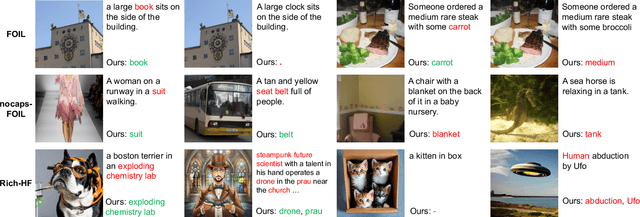
Abstract:Recent vision-language foundation models still frequently produce outputs misaligned with their inputs, evidenced by object hallucination in captioning and prompt misalignment in the text-to-image generation model. Recent studies have explored methods for identifying misaligned elements, aiming not only to enhance interpretability but also to improve model performance. However, current approaches primarily rely on large foundation models in a zero-shot manner or fine-tuned models with human annotations, which limits scalability due to significant computational costs. This work proposes a novel approach, dubbed CLIP4DM, for detecting dense misalignments from pre-trained CLIP, specifically focusing on pinpointing misaligned words between image and text. We carefully revamp the gradient-based attribution computation method, enabling negative gradient of individual text tokens to indicate misalignment. We also propose F-CLIPScore, which aggregates misaligned attributions with a global alignment score. We evaluate our method on various dense misalignment detection benchmarks, covering various image and text domains and misalignment types. Our method demonstrates state-of-the-art performance among zero-shot models and competitive performance with fine-tuned models while maintaining superior efficiency. Our qualitative examples show that our method has a unique strength to detect entity-level objects, intangible objects, and attributes that can not be easily detected for existing works. We conduct ablation studies and analyses to highlight the strengths and limitations of our approach. Our code is publicly available at https://github.com/naver-ai/CLIP4DM.
HyperCLOVA X Technical Report
Apr 13, 2024Abstract:We introduce HyperCLOVA X, a family of large language models (LLMs) tailored to the Korean language and culture, along with competitive capabilities in English, math, and coding. HyperCLOVA X was trained on a balanced mix of Korean, English, and code data, followed by instruction-tuning with high-quality human-annotated datasets while abiding by strict safety guidelines reflecting our commitment to responsible AI. The model is evaluated across various benchmarks, including comprehensive reasoning, knowledge, commonsense, factuality, coding, math, chatting, instruction-following, and harmlessness, in both Korean and English. HyperCLOVA X exhibits strong reasoning capabilities in Korean backed by a deep understanding of the language and cultural nuances. Further analysis of the inherent bilingual nature and its extension to multilingualism highlights the model's cross-lingual proficiency and strong generalization ability to untargeted languages, including machine translation between several language pairs and cross-lingual inference tasks. We believe that HyperCLOVA X can provide helpful guidance for regions or countries in developing their sovereign LLMs.
SCANNER: Knowledge-Enhanced Approach for Robust Multi-modal Named Entity Recognition of Unseen Entities
Apr 02, 2024



Abstract:Recent advances in named entity recognition (NER) have pushed the boundary of the task to incorporate visual signals, leading to many variants, including multi-modal NER (MNER) or grounded MNER (GMNER). A key challenge to these tasks is that the model should be able to generalize to the entities unseen during the training, and should be able to handle the training samples with noisy annotations. To address this obstacle, we propose SCANNER (Span CANdidate detection and recognition for NER), a model capable of effectively handling all three NER variants. SCANNER is a two-stage structure; we extract entity candidates in the first stage and use it as a query to get knowledge, effectively pulling knowledge from various sources. We can boost our performance by utilizing this entity-centric extracted knowledge to address unseen entities. Furthermore, to tackle the challenges arising from noisy annotations in NER datasets, we introduce a novel self-distillation method, enhancing the robustness and accuracy of our model in processing training data with inherent uncertainties. Our approach demonstrates competitive performance on the NER benchmark and surpasses existing methods on both MNER and GMNER benchmarks. Further analysis shows that the proposed distillation and knowledge utilization methods improve the performance of our model on various benchmarks.
SCOB: Universal Text Understanding via Character-wise Supervised Contrastive Learning with Online Text Rendering for Bridging Domain Gap
Sep 21, 2023Abstract:Inspired by the great success of language model (LM)-based pre-training, recent studies in visual document understanding have explored LM-based pre-training methods for modeling text within document images. Among them, pre-training that reads all text from an image has shown promise, but often exhibits instability and even fails when applied to broader domains, such as those involving both visual documents and scene text images. This is a substantial limitation for real-world scenarios, where the processing of text image inputs in diverse domains is essential. In this paper, we investigate effective pre-training tasks in the broader domains and also propose a novel pre-training method called SCOB that leverages character-wise supervised contrastive learning with online text rendering to effectively pre-train document and scene text domains by bridging the domain gap. Moreover, SCOB enables weakly supervised learning, significantly reducing annotation costs. Extensive benchmarks demonstrate that SCOB generally improves vanilla pre-training methods and achieves comparable performance to state-of-the-art methods. Our findings suggest that SCOB can be served generally and effectively for read-type pre-training methods. The code will be available at https://github.com/naver-ai/scob.
Cream: Visually-Situated Natural Language Understanding with Contrastive Reading Model and Frozen Large Language Models
May 24, 2023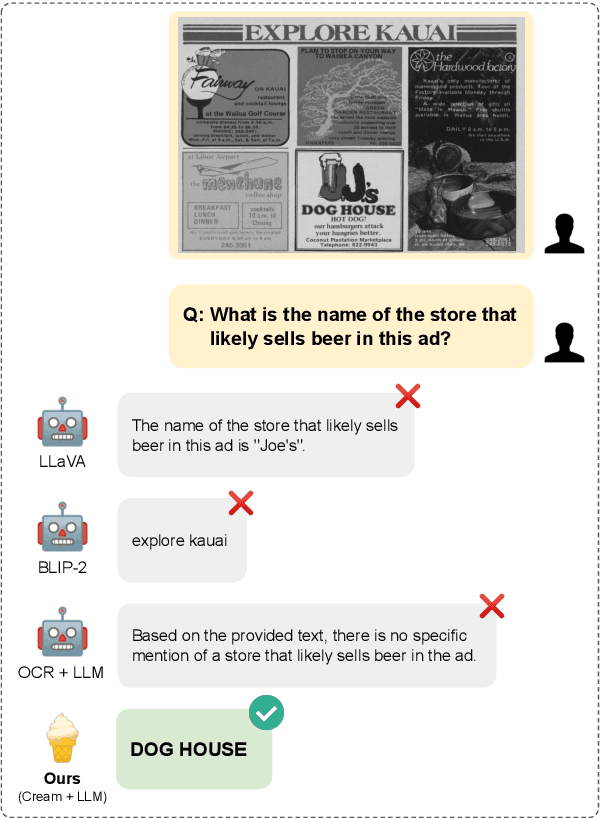
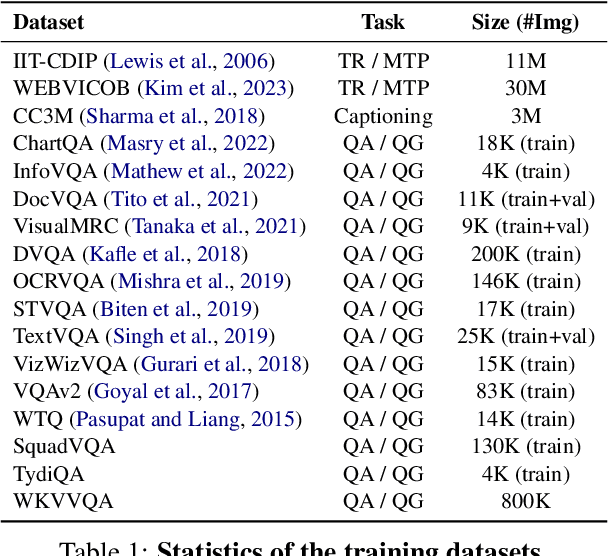
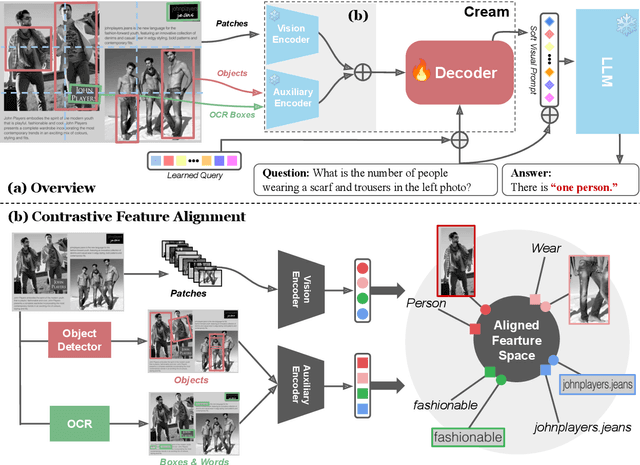

Abstract:Advances in Large Language Models (LLMs) have inspired a surge of research exploring their expansion into the visual domain. While recent models exhibit promise in generating abstract captions for images and conducting natural conversations, their performance on text-rich images leaves room for improvement. In this paper, we propose the Contrastive Reading Model (Cream), a novel neural architecture designed to enhance the language-image understanding capability of LLMs by capturing intricate details typically overlooked by existing methods. Cream integrates vision and auxiliary encoders, complemented by a contrastive feature alignment technique, resulting in a more effective understanding of textual information within document images. Our approach, thus, seeks to bridge the gap between vision and language understanding, paving the way for more sophisticated Document Intelligence Assistants. Rigorous evaluations across diverse tasks, such as visual question answering on document images, demonstrate the efficacy of Cream as a state-of-the-art model in the field of visual document understanding. We provide our codebase and newly-generated datasets at https://github.com/naver-ai/cream
Towards Unified Scene Text Spotting based on Sequence Generation
Apr 07, 2023Abstract:Sequence generation models have recently made significant progress in unifying various vision tasks. Although some auto-regressive models have demonstrated promising results in end-to-end text spotting, they use specific detection formats while ignoring various text shapes and are limited in the maximum number of text instances that can be detected. To overcome these limitations, we propose a UNIfied scene Text Spotter, called UNITS. Our model unifies various detection formats, including quadrilaterals and polygons, allowing it to detect text in arbitrary shapes. Additionally, we apply starting-point prompting to enable the model to extract texts from an arbitrary starting point, thereby extracting more texts beyond the number of instances it was trained on. Experimental results demonstrate that our method achieves competitive performance compared to state-of-the-art methods. Further analysis shows that UNITS can extract a larger number of texts than it was trained on. We provide the code for our method at https://github.com/clovaai/units.
DEER: Detection-agnostic End-to-End Recognizer for Scene Text Spotting
Mar 10, 2022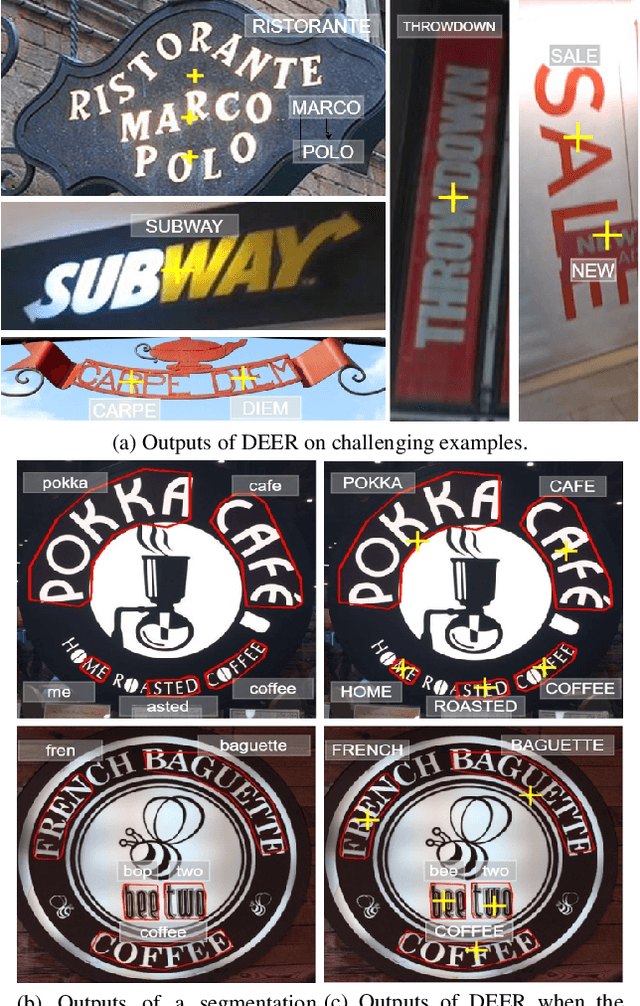
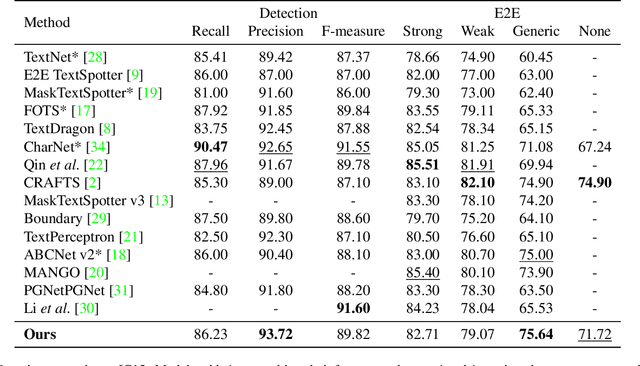
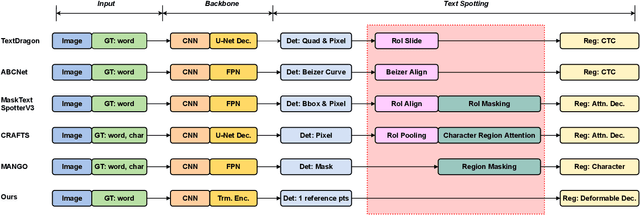
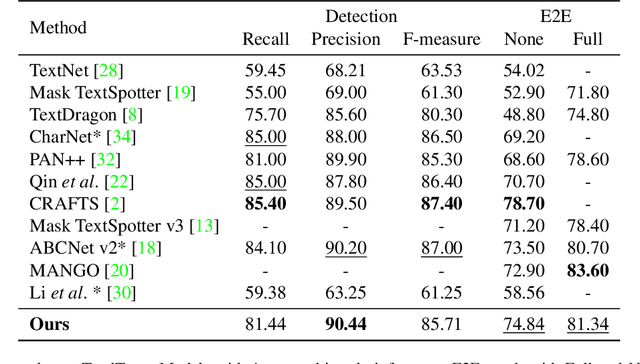
Abstract:Recent end-to-end scene text spotters have achieved great improvement in recognizing arbitrary-shaped text instances. Common approaches for text spotting use region of interest pooling or segmentation masks to restrict features to single text instances. However, this makes it hard for the recognizer to decode correct sequences when the detection is not accurate i.e. one or more characters are cropped out. Considering that it is hard to accurately decide word boundaries with only the detector, we propose a novel Detection-agnostic End-to-End Recognizer, DEER, framework. The proposed method reduces the tight dependency between detection and recognition modules by bridging them with a single reference point for each text instance, instead of using detected regions. The proposed method allows the decoder to recognize the texts that are indicated by the reference point, with features from the whole image. Since only a single point is required to recognize the text, the proposed method enables text spotting without an arbitrarily-shaped detector or bounding polygon annotations. Experimental results present that the proposed method achieves competitive results on regular and arbitrarily-shaped text spotting benchmarks. Further analysis shows that DEER is robust to the detection errors. The code and dataset will be publicly available.
 Add to Chrome
Add to Chrome Add to Firefox
Add to Firefox Add to Edge
Add to Edge